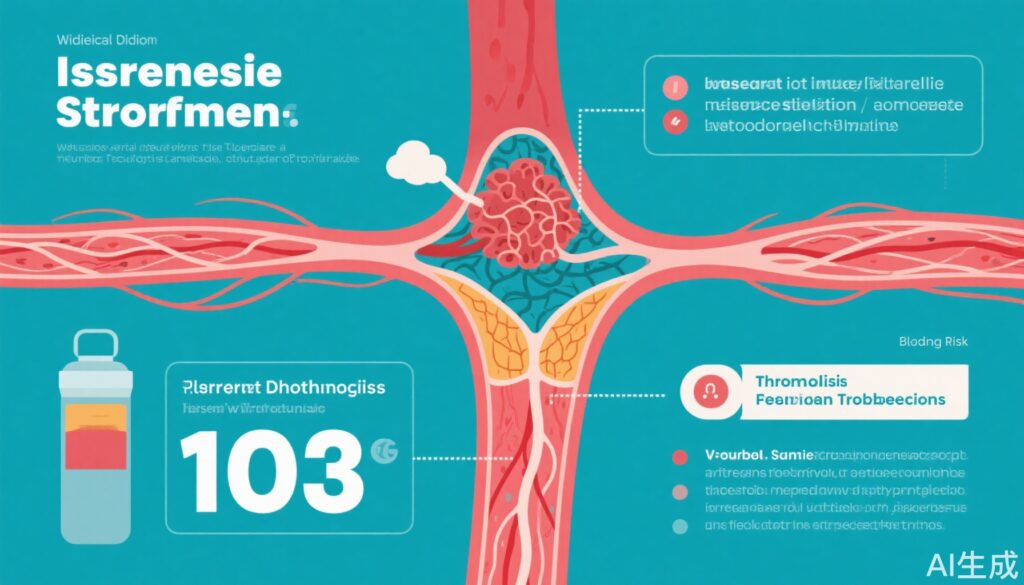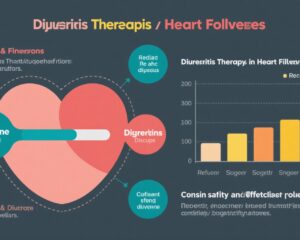Highlights
- IV thrombolysis (IVT) before endovascular treatment (EVT) slightly increases overall intracranial hemorrhage (ICH) risk in anterior circulation large vessel occlusion stroke.
- Both symptomatic and asymptomatic ICH correlate with worse functional outcomes at 90 days post-stroke.
- Elevated baseline glucose (≥140 mg/dL) and systolic blood pressure (≥140 mm Hg) amplify the ICH risk associated with IVT plus EVT.
- Despite increased hemorrhage risk, the absolute increase is modest and the clinical benefit of IVT may offset these risks.
Background
Acute ischemic stroke from large vessel occlusion (LVO) is a leading cause of disability and death worldwide. Endovascular treatment (EVT) with mechanical thrombectomy is established as standard care to restore blood flow. Intravenous thrombolysis (IVT), often with alteplase, is commonly administered prior to EVT to facilitate reperfusion. However, concerns persist regarding hemorrhagic complications when combining these approaches. Understanding the balance between efficacy and safety of IVT preceding EVT is crucial for optimizing stroke management.
Key Content
Summary of the Individual Participant Data Meta-Analysis (Zhou et al., 2025)
- Methods: This meta-analysis included data from six randomized clinical trials comprising 2,313 patients with anterior circulation LVO stroke (median age 71 years; 56% male), comparing EVT plus IVT (mostly alteplase) versus EVT alone.
- ICH Evaluation: ICH subtypes were classified using the Heidelberg Bleeding Classification on imaging within 18-72 hours post-stroke, with additional imaging up to 7 days.
- Findings: Overall ICH occurred in 34% of participants. IVT+EVT was associated with higher any ICH rate than EVT alone (36% vs 32%; adjusted odds ratio [aOR] 1.2; P=0.03) and elevated parenchymal hematoma (PH) rates (7% vs 5%; aOR 1.5; P=0.04).
- Functional Outcomes: Both symptomatic and asymptomatic ICH were linked with worse 90-day modified Rankin Scale (mRS) outcomes (adjusted common ORs 0.1 and 0.6 respectively; P<0.001).
- Effect Modifiers: Baseline hyperglycemia (glucose ≥140 mg/dL) and elevated systolic blood pressure (≥140 mm Hg) significantly increased the ICH risk associated with IVT (P-for-interaction 0.007 and 0.02 respectively).
Additional Evidence from Related Studies
- Intra-arterial thrombolysis (IAT) after EVT: Meta-analyses show no increased risk of intracranial hemorrhage or mortality but suggest potential functional benefit in AIS with LVO (Neurology, 2025).
- Bridging IVT before EVT in large infarct cores: Observational data indicate increased symptomatic ICH risk but improved functional outcomes compared with EVT alone (J Neurointerv Surg, 2025).
- Direct EVT versus bridging IVT+EVT in basilar artery occlusion: No significant difference in efficacy or safety endpoints including ICH rates in RCT subanalysis (J Neurointerv Surg, 2025).
- MR CLEAN-NO IV trial: Administration of IVT before EVT was not associated with increased symptomatic ICH or hemorrhage volume, and reperfusion reduced subarachnoid hemorrhage risk (J Neurointerv Surg, 2023).
Mechanistic Considerations
IVT promotes fibrinolysis systemically, potentially increasing the risk of bleeding complications in ischemic brain tissue vulnerable after vessel recanalization. Elevated glucose and blood pressure exacerbate blood-brain barrier disruption, augmenting hemorrhagic transformation. The delicate balance between reperfusion benefit and hemorrhagic risk underscores tailored patient selection.
Expert Commentary
The meta-analysis by Zhou et al. provides rigorous evidence that IVT prior to EVT modestly elevates the risk of intracranial hemorrhage, including more severe hemorrhages such as parenchymal hematoma. Notably, the absolute increase in ICH risk was modest, emphasizing the clinical importance of weighing hemorrhagic risk against probable benefits of early reperfusion induced by IVT. The differential impact of baseline hyperglycemia and hypertension on hemorrhagic risk highlights the necessity for individualized risk stratification and optimized peri-procedural management.
Existing guidelines retain IVT plus EVT as standard practice in eligible patients within the therapeutic window. However, accumulating data from randomized trials comparing direct EVT versus combined IVT+EVT reflect equivocal benefits with some heterogeneity, suggesting a potential role for precision medicine based on patient-specific factors, such as infarct size, occlusion location, collateral status, and comorbidities.
Emerging therapies, including intra-arterial thrombolytics and adjunctive intra-arterial antithrombotics, may offer future opportunities to enhance reperfusion while minimizing bleeding risk. Additional randomized controlled trials with standardized imaging and functional endpoints are essential to further refine treatment algorithms.
Conclusion
In patients with anterior circulation large vessel occlusion stroke, intravenous thrombolysis administered before endovascular thrombectomy modestly increases the risk and severity of intracranial hemorrhage, particularly in patients with elevated baseline glucose and blood pressure. Despite this, the absolute increase in hemorrhagic complications is limited, and the functional benefits provided by IVT continue to justify its use in most clinical scenarios. Individualized patient assessment remains crucial, and ongoing research will elucidate optimal reperfusion strategies balancing efficacy and safety.
References
- Zhou Y, Zhang L, Cavalcante F, Suzuki K, Treurniet KM, Yan B, et al.; IRIS collaborators. Intracranial Hemorrhage in Patients With Stroke After Endovascular Treatment With or Without IV Alteplase: An Individual Participant Data Meta-Analysis. JAMA Neurol. 2025 Aug 11:e252610. doi:10.1001/jamaneurol.2025.2610. PMID: 40788598; PMCID: PMC12340682.
- Neurology. 2025 Aug 12;105(3):e213842. Intra-Arterial Thrombolysis Following Endovascular Recanalization for Large Vessel Occlusion Stroke: A Systematic Review and Meta-Analysis. doi:10.1212/WNL.0000000000213842.
- J Neurointerv Surg. 2025 Jun 1;17(e2):e222-e230. Bridging thrombolysis before endovascular therapy is associated with better outcomes in patients with large infarction core. doi:10.1136/jnis-2024-021958.
- J Neurointerv Surg. 2025 Jun 1;17(e2):e381-e387. Thrombectomy versus combined thrombolysis for acute basilar artery occlusion: a secondary analysis of the ATTENTION trial. doi:10.1136/jnis-2024-021678.
- J Neurointerv Surg. 2023 Nov;15(e2):e262-e269. Hemorrhage rates in patients with acute ischemic stroke treated with intravenous alteplase and thrombectomy versus thrombectomy alone. doi:10.1136/jnis-2022-019569.



